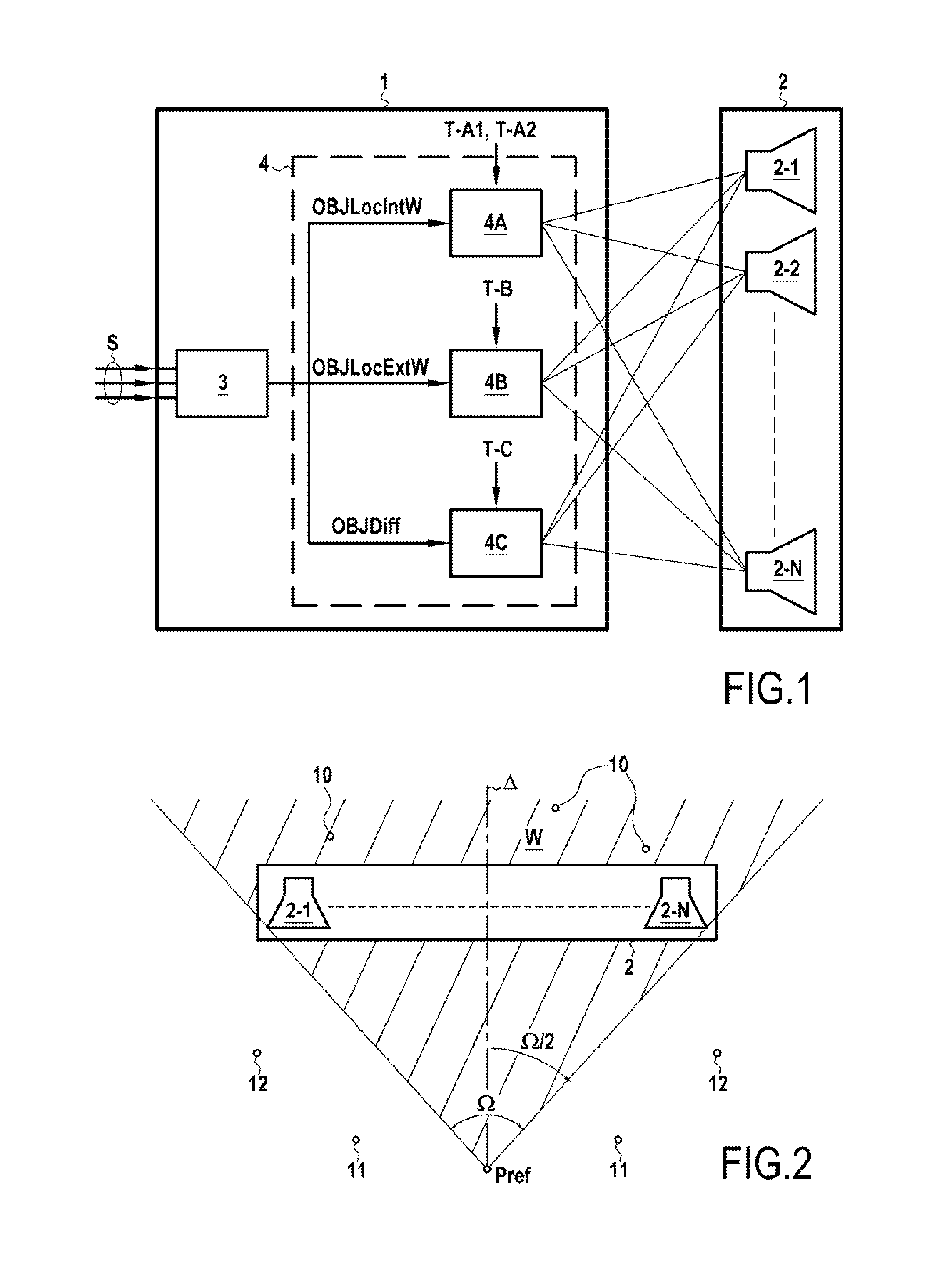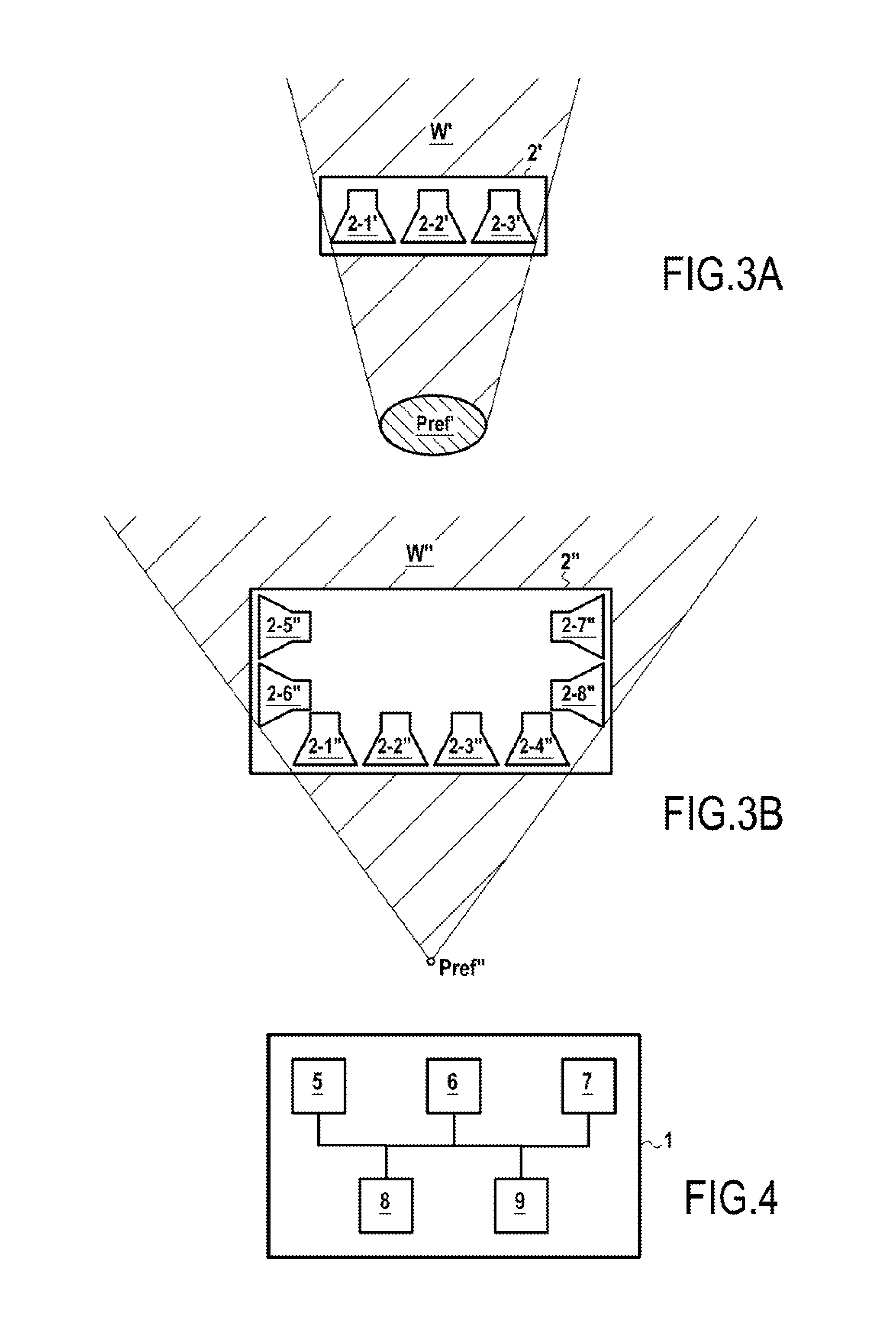Method and system for playing back an audio signal
a multi-channel audio and audio signal technology, applied in the direction of loudspeaker spatial/constructional arrangement, stereophonic arrangment, electrical equipment, etc., to achieve the effect of better control, better control over the directivity of sound sources, and better control of sound playback accuracy
- Summary
- Abstract
- Description
- Claims
- Application Information
AI Technical Summary
Benefits of technology
Problems solved by technology
Method used
Image
Examples
example 1
[0209]In this first example, it is assumed that the playback device 2 is an acoustic enclosure of the horizontal soundbar type having three loudspeakers 2-1, 2-2, and 2-3 (a central loudspeaker and two lateral loudspeakers).
[0210]The position Pref is selected to be a point, centered relative to the playback device 2.
[0211]It is also assumed that the multichannel signal S delivered to the playback system 1 during the step E10 is a stereo audio signal, in other words is a signal made up of two distinct channels.
[0212]In this first example, the following steps are performed by the playback system 1 on the signal S:
[0213]1) Decomposing the signal S into frequency sub-bands in step E30 with the help of a Fourier transform applied to the signal S, each frequency sub-band comprising a signal Si that is itself made up of two channels.
[0214]2) Spatially analyzing ΣI the signal S, or in equivalent manner each signal Si in each frequency sub-band, by performing time analysis of the signal Si d...
example 2
[0228]In this second example, it is assumed that the playback device 2 is a compact acoustic enclosure of the horizontal soundbar type having 15 loudspeakers 2-1, 2-2, . . . , 2-15 and having a length of about 1 m.
[0229]The position Pref is selected to be a point that is centered relative to the playback device 2.
[0230]It is also assumed that the multichannel signal S delivered to the playback system 1 during step E10 is a 5.1 audio signal. Such a signal already contains spatialization information intrinsically. More specifically, the ITU-R BS.775-1 standard defining the format of 5.1 signals assumes a center situated at 0°, left and right channels L and R situated at ±30° relative to the center, and rear left and rear right channels Ls and Rs situated at ±110° relative to the center.
[0231]In this second example, the following steps are performed by the playback system 1 on the basis of the signal S:
[0232]1) Decomposing the signal S into frequency sub-bands in step E20 using a Fouri...
example 3
[0250]In this third example, it is assumed that the playback device 2 is a compact acoustic enclosure having eight loudspeakers 2-1, 2-2, . . . , 2-8, and having a width of about 80 cm, with four front loudspeakers 2-1, . . . , 2-4, and two respective pairs of loudspeakers 2-5&2-6 and 2-7&2-8 situated on opposite sides of the device 2 (device similar to device 2″ shown in FIG. 3B).
[0251]The position Pref is selected to be a point, centered relative to the playback device 2.
[0252]It is also assumed that the multichannel signal S delivers to the playback system 1 during the step E10 is an audio signal made up of four distinct channels.
[0253]In this third example, the following steps are performed by the playback system 1 on the signal S:
[0254]1) Decomposing the signal S into frequency sub-bands in step E20 using a Fourier transform applied to the signal S, each frequency sub-band comprising a signal Si made up of four channels.
[0255]2) Spatially analyzing ΣI the signal S, or in equiva...
PUM
 Login to View More
Login to View More Abstract
Description
Claims
Application Information
 Login to View More
Login to View More - R&D
- Intellectual Property
- Life Sciences
- Materials
- Tech Scout
- Unparalleled Data Quality
- Higher Quality Content
- 60% Fewer Hallucinations
Browse by: Latest US Patents, China's latest patents, Technical Efficacy Thesaurus, Application Domain, Technology Topic, Popular Technical Reports.
© 2025 PatSnap. All rights reserved.Legal|Privacy policy|Modern Slavery Act Transparency Statement|Sitemap|About US| Contact US: help@patsnap.com



